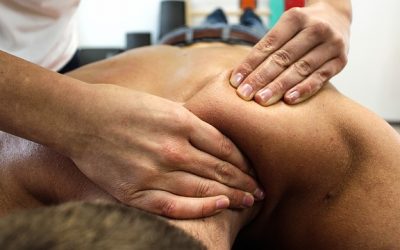6 Proven Benefits Of Deep Tissue Massage
While some massages relax and rejuvenate your body, deep tissue massage has therapeutic effects which are capable of healing your body and repairing muscles, tissues, and joints. The slow, firm strokes against the grain of the muscle may cause some discomfort because deep tissue massage impacts deep layers of muscle and connecting tissues known as fascia.
The use of massage as a way to treat chronic pain and other musculoskeletal ailments has been on for thousands of years. Ayurveda prescribes specific oil-based massages to treat muscle injuries and for detoxification. Ancient Egyptian and Chinese civilizations have also used pressure massages to improve health and maintain a healthy liver. In modern times, deep tissue massage has been used to supplement muscle recovery and treat chronic conditions because of the many benefits it offers.
What Is Deep Tissue Massage
Deep tissue massage is a specific type of massage that works on the deep layers of muscle and fascia in the body. A fascia is a band or sheet of connective tissue beneath the skin, consisting primarily of collagen. It attaches, stabilizes, encloses, and separates muscles and other internal organs.
Unlike Swedish massage, which has a relaxing effect and uses lighter pressure, deep tissue massage is done using deep finger pressure with strokes that are firm and slow. Deep tissue massage has several therapeutic effects and can be used to treat many different conditions. This type of massage is ideal for the treatment of major muscle groups like the neck or lower back. It can also be used to relieve strain and treat injuries in your joints and tendons.
What To Expect
The first thing to bear in mind is that deep tissue massage is used for therapy and rehabilitation, not relaxation. So you need to be prepared to feel some discomfort during a deep tissue massage and even after. You will most probably lie on your stomach or back while the massage therapist applies various degrees of pressure on tight muscles that have issues and are lying dormant in your body.
You will experience some pain during the massage as this form of massage concentrates on relieving strain and tension from tissues that go deeper. The pain could also be because the massage uses movements against the muscles rather than moving with them. But if you think you’re experiencing intense pain, immediately inform your therapist. The best way to make the most of a deep tissue massage is to be as relaxed as you can and trust your therapist to massage your pain away. That’s why it’s important to go to a certified and experienced massage therapist for a deep tissue massage.
Benefits Of Deep Tissue Massage
1. Lowers High Blood Pressure
Since deep tissue massage is designed to work on the deep layers of tissue in the body, it also has an impact on your blood flow. In 2008, a study was conducted with 263 volunteers with an average age of 48.5 years who were suffering from moderate or severe muscle strain. Each patient was given a deep tissue massage for 45-60 minutes. Blood pressure readings showed a dip when compared to readings taken before the massage indicating that deep tissue massage has a positive impact on lowering blood pressure. Though the exact mechanism of how this happens needs more study, you could use deep tissue massage as part of a holistic approach to treating hypertension.
2. Reduces Stress And Anxiety
Deep tissue massage could also be a solution to all that stress life throws at you. Studies have shown that massage can increase the production of a hormone called oxytocin. This hormone is also known as the bonding hormone as it influences social interactions and creates positive emotions. Massage also helps reduce blood pressure and cortisol levels.
3. Treats Back Pain
According to the American Chiropractic Association, 31 million Americans experience low-back pain at any given time. When researchers conducted experiments to confirm if indeed deep tissue massage
helped reduce chronic back pain, they found that the effect of deep tissue massage significantly reduced chronic lower back pain. In fact, in another study, deep tissue massage scored higher than therapeutic massage for treatment of lower back pain.
4. Helps Manage Labor Pain
Labor pain has been described as one of the most intense pains a human being can endure. Studies have supported the claim that massage therapy can be an effective way to reduce labor pain during pregnancy. Women who received massage therapy reported decreased depression, anxiety, and leg and back pain. It was also found that the rate of prematurity was lower and labors durations were on average 3 hours shorter with less need for medication.
5. Decreases Arthritis Symptoms
Depending on what stage you are, arthritis can severely affect your quality of life. Even doing regular activities like typing on your computer and gardening can be quite painful. According to the Arthritis Foundation, massage therapy has led to improvements in pain, stiffness, range of motion, hand grip strength and overall function of the joints.7However, massage therapy is a complement to your doctor-prescribed arthritis treatment and not a treatment in itself.
6. Aids Muscle Rehabilitation In Athletes
Muscle injury and soreness are an occupational hazard when it comes to athletics. Coaches, athletes, and professionals in the field of sports medicine have found that massage can provide several benefits to the body such as increased blood flow, reduced muscle tension, and an increased sense of well-being. The majority of research on psychological effects of massage has concluded that massage produces positive effects on recovery and post-exercise massage has been shown to reduce the severity of muscle soreness. While there is no research focusing specifically on the benefits of deep tissue massage on muscle rehabilitation, studies find that massage therapy, in general, can help with performance, recovery, and muscle injury prevention.
Precautions
Because of the therapeutic nature of deep tissue massage, you should be careful on some fronts before you have one. Here are a few precautions to remember:
- Do not opt for deep tissue massage if you have been diagnosed with blood clots in the past since the massage may dislodge the clots. Talk to your doctor of you have or are at risk of forming blood clots.
- Check with your doctor if you have had chemotherapy, radiation, recent surgery, or any medical condition. Also, avoid deep tissue massage if you have osteoporosis.
- Inform your massage therapist if you have inflamed or infected skin, bruises, unhealed/open wounds, tumors, abdominal hernia, fragile bones, or recent fractures. Massaging on these areas is not advisable.
- If you have any medical condition, especially ailments that affect bones, muscles, or joints, consult your doctor before undergoing deep tissue massage.
- Deep tissue massage or any strong pressure should be avoided during pregnancy, however, your doctor may suggest a massage therapist trained in pregnancy massage.
What sets deep tissue massage apart is its ability to impact deeper layers of muscle and tissue. This also means that getting a deep tissue massage is more about stimulation than relaxation. If you have regular aches and pains due to bad posture or stiffness/soreness because of the nature of your work, deep tissue massage can help relieve the pain and soreness. But before you book an appointment, talk to your massage therapist about specific areas of your body that need relief. Also, keep in mind that a massage is not a complete treatment in itself. For acute pain and chronic conditions, consult your doctor first.









I really appreciate your information that Swedish massage uses lighter pressure as a relaxing effect while deep tissue massage’s therapeutic techniques focus on relieving tension and strain. With this information, I think that I should look into deep tissue massage. Since having my children, I have had a lot of back pain when resting and moving.
Yes Sarah! We get a lot of parents that need Massage Therapy to help keep them going! It’s a lot of work chases the little ones!